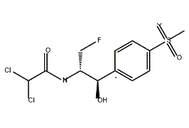Florfenicol is currently a commonly used veterinary antibiotic with a broad antibacterial spectrum and a strong antibacterial effect as well as a low the minimum inhibitory concentration (MIC). The antibacterial of florfenicol is about 15-20 times as high as that of chloramphenicol and the thiamphenicol. After administration through feed for 60 minutes, the drug concentration in the tissue can reach peak which can quickly control the disease with having characteristics such as being safe, non-toxic, no residue, and no risk for triggering aplastic anemia. Therefore, it is quite suitable for large-scale farms application. It is mainly used for the treatment of bovine respiratory disease caused by Pasteurella and Haemophilus. It has good efficacy in treating the cattle footrot disease cause by Fusobacterium, and can be also used for treating the infection diseases of pigs and chickens caused by sensitive strains as well as the bacterial disease of fish.
It is not easy for bacteria to evolve resistance against florfenicol: Because it has a fluorine atom which replaces the hydroxyl group on the molecular structure of thiamphenicol, thus effectively solving the drug resistant issue of chloramphenicol, and thiamphenicol. Bacteria which are resistant to thiamphenicol, chloramphenicol, amoxicillin, and quinolone remain sensitive to the chemicals.
Florfenicol is characterized by: a broad spectrum antibiotic; Salmonella, Escherichia coli, Proteus, Haemophilus, Actinobacillus pleuropneumoniae, Mycoplasma hyopneumoniae, Streptococcus Suis, swine Pasteurella, Bordetclla bronchiseptica, and Staphylococcus aureus are all sensitive to it. The drug is easy for absorbing and is widely distributed in the body and is quick-acting and long-acting formulations with no potential risk of causing aplastic anemia risks and thus having a better security. In addition, it has an affordable price which is cheaper than other drugs for prevention and treatment of respiratory diseases such as tiamulin, tilmicosin, and azithromycin. The cost of medication is easy for users to accept. Because of all these excellent characteristics, domestic florfenicol is widely applied and has currently become the first-choice drug for prevention and treatment of livestock respiratory diseases and gastrointestinal bacterial infection diseases.
